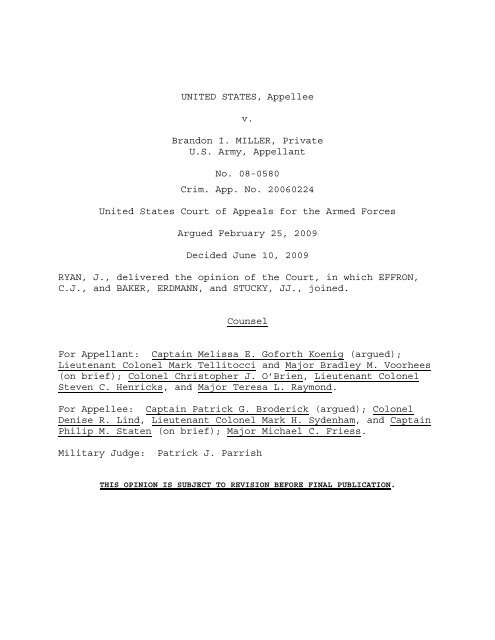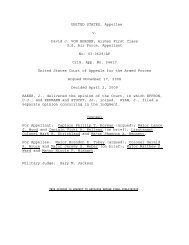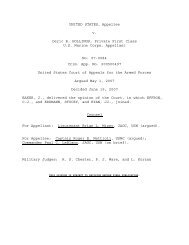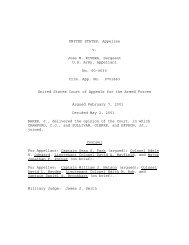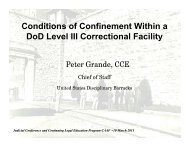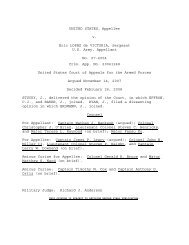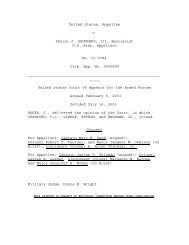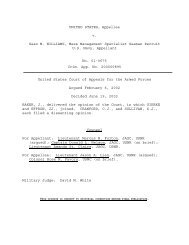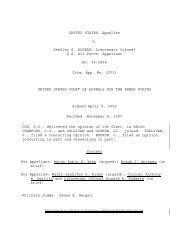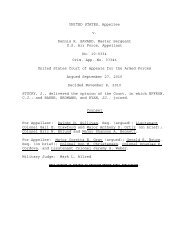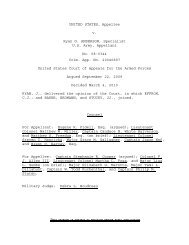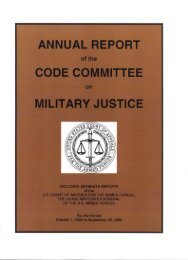United States v. Miller - U.S. Court of Appeals for the Armed Forces
United States v. Miller - U.S. Court of Appeals for the Armed Forces
United States v. Miller - U.S. Court of Appeals for the Armed Forces
Create successful ePaper yourself
Turn your PDF publications into a flip-book with our unique Google optimized e-Paper software.
<strong>United</strong> <strong>States</strong> v. <strong>Miller</strong>, 08-0580/ARoccurred at Camp Red Cloud, South Korea, on March 11, 2005.Early that morning, MPs were called to take custody <strong>of</strong> Appellantfrom <strong>the</strong> Korean National Police (KNP), who had apprehendedAppellant <strong>for</strong> an alleged assault. The MPs arrived at <strong>the</strong> KNPguard box at <strong>the</strong> gate <strong>of</strong> Camp Red Cloud and proceeded to takeAppellant into military custody. As <strong>the</strong> MPs went to place handirons on Appellant, he ran to <strong>the</strong> door <strong>of</strong> <strong>the</strong> room, but wasunable to leave because it was locked. Appellant struggled with<strong>the</strong> MPs and members <strong>of</strong> <strong>the</strong> KNP -- hitting one KNP investigator-- and was eventually subdued.At Appellant’s subsequent court-martial, <strong>the</strong> panelconvicted him, contrary to his pleas, inter alia, <strong>of</strong> resistingapprehension in violation <strong>of</strong> Article 95, UCMJ, 10 U.S.C. § 895(2000). 2 On appeal, <strong>the</strong> <strong>United</strong> <strong>States</strong> Army <strong>Court</strong> <strong>of</strong> Criminal<strong>Appeals</strong> (CCA) found <strong>the</strong> evidence factually insufficient to prove<strong>the</strong> resisting apprehension charge, as Appellant was already incustody when <strong>the</strong> MPs came to <strong>the</strong> KNP guard box. <strong>United</strong> <strong>States</strong>v. <strong>Miller</strong>, No. ARMY 20060224, slip op. at 4 (A. Ct. Crim. App.Mar. 24, 2008). The CCA stated:The panel convicted appellant <strong>of</strong> resistingapprehension by Private First Class (PFC) ES, amilitary police <strong>of</strong>ficer (MP) at <strong>the</strong> Korean National2 Appellant does not challenge his convictions <strong>of</strong> unrelatedcharges <strong>of</strong> going absent without leave, assaulting anoncommissioned <strong>of</strong>ficer, and using provoking words in violation<strong>of</strong> Articles 86, 91, and 117, UCMJ, 10 U.S.C. §§ 886, 891, 917(2000), respectively.3
<strong>United</strong> <strong>States</strong> v. <strong>Miller</strong>, 08-0580/ARPolice (KNP) “box” outside <strong>the</strong> gate <strong>of</strong> Camp Red Cloud(CRC), Republic <strong>of</strong> Korea on 11 March 2005. PrivateFirst Class ES, his partner, and Mr. H, a KoreanNational Investigator, responded to a radio call totake custody <strong>of</strong> appellant at <strong>the</strong> CRC gate. Upon <strong>the</strong>irarrival, appellant was in hand irons in <strong>the</strong> custody <strong>of</strong><strong>the</strong> KNPs. Once <strong>the</strong> hand irons were removed, PFC EStestified that appellant “sprinted to <strong>the</strong> door[.]”While <strong>the</strong> MPs continued <strong>the</strong>ir ef<strong>for</strong>ts to put <strong>the</strong>accused in hand irons, he kept “trying to fight us”and was “swinging his arms around . . . kept turning,making it hard <strong>for</strong> [<strong>the</strong> MPs] to grab his arms” atwhich time appellant hit Mr. H. The KNPs again putappellant in custody until he was taken to <strong>the</strong> KNPstation later that night.Based on <strong>the</strong>se facts and <strong>the</strong> definitionsdescribed above, at <strong>the</strong> time <strong>of</strong> <strong>the</strong> <strong>of</strong>fense, <strong>the</strong> KNPshad placed appellant in custody and were transferringcustody <strong>of</strong> appellant to <strong>the</strong> MPs. Consequently, <strong>the</strong>evidence is factually insufficient and we cannotaffirm appellant’s conviction to resistingapprehension. See <strong>United</strong> <strong>States</strong> v. Chavez, 6 M.J. 615(A.C.M.R. 1978) (holding that because <strong>the</strong> guardsalready apprehended <strong>the</strong> accused and had him incustody, a conviction <strong>for</strong> resisting apprehension fails<strong>for</strong> factual insufficiency[]).Id. at 4 (first set <strong>of</strong> brackets and ellipsis in original).The CCA, however, proceeded to find Appellant guilty <strong>of</strong> asimple disorder under Article 134, UCMJ, as a lesser included<strong>of</strong>fense, asserting that this <strong>Court</strong> has:long recognized that an appellate court maydisapprove a finding because pro<strong>of</strong> <strong>of</strong> anessential element is lacking or, as a result <strong>of</strong>instructional errors . . . may substitute alesser-included <strong>of</strong>fense <strong>for</strong> <strong>the</strong> disapprovedfindings. This is true even if <strong>the</strong> lesserincluded<strong>of</strong>fense was nei<strong>the</strong>r considered norinstructed upon at <strong>the</strong> trial <strong>of</strong> <strong>the</strong> case.<strong>United</strong> <strong>States</strong> v. McKinley, 27 M.J. 78, 79 (C.M.A.1988) (emphasis added). . . .4
<strong>United</strong> <strong>States</strong> v. <strong>Miller</strong>, 08-0580/ARThe evidence presented at trial firmlyestablished that appellant’s conduct was prejudicialto good order and discipline or service discreditingand constituted a simple disorder under Article 134,UCMJ. See <strong>United</strong> <strong>States</strong> v. Fuller, 54 M.J. 107, 112(C.A.A.F. 2000) (holding evidence in a contestedtrial failed to support maltreatment <strong>of</strong>fense, but wassufficient support <strong>for</strong> reviewing court to affirm aviolation <strong>of</strong> Article 134, UCMJ); <strong>United</strong> <strong>States</strong> v.Augustine, 53 M.J. 95 (C.A.A.F. 2000) (holdingadmissions during providence inquiry sufficient <strong>for</strong>reviewing court to affirm a violation <strong>of</strong> Article 134,UCMJ); <strong>United</strong> <strong>States</strong> v. Sapp, 53 M.J. 90 (C.A.A.F.2000) (affirming a violation <strong>of</strong> <strong>the</strong> general article,simple disorder, when insufficient evidence existedto support <strong>the</strong> greater <strong>of</strong>fense <strong>of</strong> violation <strong>of</strong> 28U.S.C. § 2252 (a)(4)(A)). “Conduct is punishableunder Article 134 if it is prejudicial to good orderand discipline in <strong>the</strong> armed <strong>for</strong>ces or is <strong>of</strong> a natureto bring discredit upon <strong>the</strong> armed <strong>for</strong>ces.” Fuller,54 M.J. at 112. Appellant’s conduct was both, whenin <strong>the</strong> presence <strong>of</strong> <strong>the</strong> KNPs appellant hit Mr. H andstruggled with <strong>the</strong> MPs at <strong>the</strong> CRC gate. Fur<strong>the</strong>rmore,“appellant was clearly on notice <strong>of</strong> this lesserincluded<strong>of</strong>fense because every enumerated <strong>of</strong>fenseunder <strong>the</strong> UCMJ is per se prejudicial to good orderand discipline or service-discrediting.” Id.(citing <strong>United</strong> <strong>States</strong> v. Foster, 40 M.J. 140, 143(C.M.A. 1994)). As such, we affirm <strong>the</strong> lesserincluded<strong>of</strong>fense <strong>of</strong> simple disorder.Id. at 4-5 (emphasis in original).II. DiscussionThe threshold question is whe<strong>the</strong>r a simple disorder underArticle 134, UCMJ, 3was a lesser included <strong>of</strong>fense <strong>of</strong> <strong>the</strong>3 Elements <strong>of</strong> Article 134, clauses 1 and 2, are: (1) <strong>the</strong> accuseddid or failed to do certain acts; and (2) under <strong>the</strong>circumstances, <strong>the</strong> accused’s conduct was to <strong>the</strong> prejudice <strong>of</strong>good order and discipline or was <strong>of</strong> a nature to bring discreditupon <strong>the</strong> armed <strong>for</strong>ces. Manual <strong>for</strong> <strong>Court</strong>s-Martial, <strong>United</strong> <strong>States</strong>pt. IV, para. 60.b (2002 ed.) (MCM).5
<strong>United</strong> <strong>States</strong> v. <strong>Miller</strong>, 08-0580/ARviolation <strong>of</strong> Article 95, UCMJ, 4in this case. Whe<strong>the</strong>r an <strong>of</strong>fenseis a lesser included <strong>of</strong>fense is a question <strong>of</strong> law we review denovo. <strong>United</strong> <strong>States</strong> v. Hudson, 59 M.J. 357, 359 (C.A.A.F.2004); <strong>United</strong> <strong>States</strong> v. Palagar, 56 M.J. 294, 296 (C.A.A.F.2002).The Constitution requires that an accused be on notice asto <strong>the</strong> <strong>of</strong>fense that must be defended against, and that onlylesser included <strong>of</strong>fenses that meet <strong>the</strong>se notice requirements maybe affirmed by an appellate court. Jackson v. Virginia, 443U.S. 307, 314 (1979) (“It is axiomatic that a conviction upon acharge not made or upon a charge not tried constitutes a denial<strong>of</strong> due process.”); In re Winship, 397 U.S. 358, 364 (1970)(“[T]he Due Process Clause protects <strong>the</strong> accused againstconviction except upon pro<strong>of</strong> beyond a reasonable doubt <strong>of</strong> everyfact necessary to constitute <strong>the</strong> crime with which he ischarged.”); Cole v. Arkansas, 333 U.S. 196, 201 (1948) (“Noprinciple <strong>of</strong> procedural due process is more clearly establishedthan . . . notice <strong>of</strong> <strong>the</strong> specific charge, and a chance to beheard in a trial <strong>of</strong> <strong>the</strong> issues raised by that charge . . . .”)(emphasis added). “[A]ppellate courts are not free to revise<strong>the</strong> basis on which a defendant is convicted simply because <strong>the</strong>4 Elements <strong>of</strong> resisting apprehension under Article 95, UCMJ, are:(1) a certain person attempted to apprehend <strong>the</strong> accused; (2) <strong>the</strong>said person was authorized to apprehend <strong>the</strong> accused; and (3) <strong>the</strong>6
<strong>United</strong> <strong>States</strong> v. <strong>Miller</strong>, 08-0580/ARsame result would likely obtain on retrial.” Dunn v. <strong>United</strong><strong>States</strong>, 442 U.S. 100, 107 (1979); see also Chiarella v. <strong>United</strong><strong>States</strong>, 445 U.S. 222, 236-37 (1980) (stating that <strong>the</strong> <strong>Court</strong>would not affirm a conviction based on a <strong>the</strong>ory not presented to<strong>the</strong> jury). “To uphold a conviction on a charge that was nei<strong>the</strong>ralleged in an indictment nor presented to a jury at trial<strong>of</strong>fends <strong>the</strong> most basic notions <strong>of</strong> due process.” Dunn, 442 U.S.at 106.Article 79, UCMJ, which provides that an accused “may befound guilty <strong>of</strong> an <strong>of</strong>fense necessarily included in <strong>the</strong> <strong>of</strong>fensecharged,” is consonant with <strong>the</strong>se constitutional principles, andapplies at both <strong>the</strong> trial and appellate levels. See Article 59,UCMJ (allowing an appellate court to affirm a conviction to alesser included <strong>of</strong>fense). In <strong>the</strong> explanation <strong>of</strong> Article 79,UCMJ, <strong>the</strong> President advises that “[a] lesser <strong>of</strong>fense is includedin a charged <strong>of</strong>fense when <strong>the</strong> specification contains allegationswhich ei<strong>the</strong>r expressly or by fair implication put <strong>the</strong> accused onnotice to be prepared to defend against it in addition to <strong>the</strong><strong>of</strong>fense specifically charged.” MCM pt. IV, para. 3.b(1). 5The notice requirement is met when “<strong>the</strong> elements <strong>of</strong> <strong>the</strong>accused actively resisted <strong>the</strong> apprehension. MCM pt. IV, para.19.b(1).5 “Although MCM explanations <strong>of</strong> <strong>of</strong>fenses are not binding on this<strong>Court</strong>, <strong>the</strong>y are generally treated as persuasive authority, to beevaluated in light <strong>of</strong> this <strong>Court</strong>’s precedent.” <strong>United</strong> <strong>States</strong> v.<strong>Miller</strong>, 67 M.J. 87, 89 (C.A.A.F. 2008) (citations omitted).7
<strong>United</strong> <strong>States</strong> v. <strong>Miller</strong>, 08-0580/ARlesser <strong>of</strong>fense are a subset <strong>of</strong> <strong>the</strong> elements <strong>of</strong> <strong>the</strong> charged<strong>of</strong>fense.” Schmuck v. <strong>United</strong> <strong>States</strong>, 489 U.S. 705, 716 (1989);see <strong>United</strong> <strong>States</strong> v. Weymouth, 43 M.J. 329, 331-34 (C.A.A.F.1995) (analyzing lesser included <strong>of</strong>fenses in <strong>the</strong> military under<strong>the</strong> Schmuck test). An accused is “by definition on notice” <strong>of</strong> alesser included <strong>of</strong>fense “because it is a subset <strong>of</strong> <strong>the</strong> greater<strong>of</strong>fense alleged.” <strong>United</strong> <strong>States</strong> v. Medina, 66 M.J. 21, 27(C.A.A.F. 2008).Appellant argues that, in this case, simple disorder is notan <strong>of</strong>fense necessarily included in resisting apprehension under<strong>the</strong> Schmuck test, because Article 134, UCMJ, has an element notpresent in Article 95, UCMJ. We agree that Article 134, UCMJ,clauses 1 and 2 include <strong>the</strong> element that, in addition to doingor failing to do a certain act, “under <strong>the</strong> circumstances, <strong>the</strong>accused’s conduct was to <strong>the</strong> prejudice <strong>of</strong> good order anddiscipline or was <strong>of</strong> a nature to bring discredit upon <strong>the</strong> armed<strong>for</strong>ces” -- an element not contained in <strong>the</strong> textual exposition <strong>of</strong>Article 95, UCMJ.To be sure, language in <strong>United</strong> <strong>States</strong> v. Foster and itsprogeny suggests that a charged violation <strong>of</strong> an enumeratedarticle, without more, provides sufficient notice <strong>of</strong> <strong>the</strong> element<strong>of</strong> prejudice to good order and discipline or servicediscrediting conduct. See Foster, 40 M.J. 140, 143 (C.M.A.1994) (stating that an accused is on notice <strong>of</strong> an Article 134,8
<strong>United</strong> <strong>States</strong> v. <strong>Miller</strong>, 08-0580/ARUCMJ, lesser included <strong>of</strong>fense because every enumerated <strong>of</strong>fenseunder <strong>the</strong> UCMJ is “per se” prejudicial to good order anddiscipline or service discrediting); see also <strong>United</strong> <strong>States</strong> v.Fuller, 54 M.J. 107, 112 (C.A.A.F. 2000) (“[E]very enumerated<strong>of</strong>fense under <strong>the</strong> UCMJ is per se prejudicial to good order anddiscipline or service-discrediting.”); <strong>United</strong> <strong>States</strong> v. Sapp, 53M.J. 90, 92 n.2 (C.A.A.F. 2000) (“[T]he elements <strong>of</strong> prejudice togood order and discipline and discredit to <strong>the</strong> armed <strong>for</strong>ces areimplicit in every enumerated <strong>of</strong>fense.”); <strong>United</strong> <strong>States</strong> v.Britton, 47 M.J. 195, 198 (C.A.A.F. 1997) (“[A]n <strong>of</strong>fense underArticle 134 can be a lesser-included <strong>of</strong>fense <strong>of</strong> an <strong>of</strong>fense underan enumerated Article, notwithstanding <strong>the</strong> requirement underArticle 134 to prove that <strong>the</strong> conduct was prejudicial orservice-discrediting.”).But as our opinion last term in Medina made clear, <strong>the</strong>principle <strong>of</strong> fair notice mandates that “an accused has a rightto know to what <strong>of</strong>fense and under what legal <strong>the</strong>ory” he will beconvicted and that a lesser included <strong>of</strong>fense meets this noticerequirement if “it is a subset <strong>of</strong> <strong>the</strong> greater <strong>of</strong>fense alleged.”66 M.J. at 26-27. This precedent is consistent with <strong>the</strong>Constitution and Supreme <strong>Court</strong> precedent regarding due process.Id. at 24 (citing Schmuck, 489 U.S. at 716); see also <strong>United</strong><strong>States</strong> v. Wilcox, 66 M.J. 442, 448 (C.A.A.F. 2008) (noting that“[t]o satisfy <strong>the</strong> due process requirements <strong>of</strong> <strong>the</strong> Fifth9
<strong>United</strong> <strong>States</strong> v. <strong>Miller</strong>, 08-0580/ARAmendment, <strong>the</strong> Government must prove beyond a reasonable doubtevery element <strong>of</strong> <strong>the</strong> charged <strong>of</strong>fense” (citing In re Winship, 397U.S. at 364)). In contrast, <strong>the</strong> above cited language fromFoster and its progeny is at odds with <strong>the</strong>se principles. To <strong>the</strong>extent those cases support <strong>the</strong> proposition that clauses 1 and 2<strong>of</strong> Article 134, UCMJ, are per se included in every enumerated<strong>of</strong>fense, <strong>the</strong>y are overruled.Article 134, UCMJ, is not an <strong>of</strong>fense necessarily includedin Article 95, UCMJ. 6Consequently, <strong>the</strong> CCA was not authorizedto affirm a finding <strong>of</strong> guilt to a simple disorder under Article134, UCMJ. See <strong>United</strong> <strong>States</strong> v. Riley, 50 M.J. 410, 415(C.A.A.F. 1999) (“An appellate court may not affirm an included<strong>of</strong>fense on ‘a <strong>the</strong>ory not presented to <strong>the</strong>’ trier <strong>of</strong> fact.”(quoting Chiarella, 445 U.S. at 236)).The decision <strong>of</strong> <strong>the</strong> <strong>United</strong> <strong>States</strong> Army <strong>Court</strong> <strong>of</strong> Criminal<strong>Appeals</strong> is reversed. The finding <strong>of</strong> guilty <strong>of</strong> Charge III and6 Our opinion in Medina also noted that when comparing <strong>the</strong>elements <strong>of</strong> two <strong>of</strong>fenses reveals that one <strong>of</strong>fense is notnecessarily a lesser included <strong>of</strong>fense <strong>of</strong> <strong>the</strong> o<strong>the</strong>r, <strong>the</strong>requirement <strong>of</strong> notice to an accused may be met if <strong>the</strong> chargesheet “make[s] <strong>the</strong> accused aware <strong>of</strong> any alternative <strong>the</strong>ory <strong>of</strong>guilt.” Medina, 66 M.J. at 27; see also MCM pt. IV, para.3.b.(1) (“The notice requirement may also be met, depending on<strong>the</strong> allegations in <strong>the</strong> specification, even though an included<strong>of</strong>fense requires pro<strong>of</strong> <strong>of</strong> an element not required in <strong>the</strong> <strong>of</strong>fensecharged.”). In this case, <strong>the</strong> charged <strong>of</strong>fense as presented to<strong>the</strong> members did not reference <strong>the</strong> elements <strong>of</strong> prejudice to goodorder or service discrediting conduct such that <strong>the</strong>specification would have put Appellant on notice <strong>of</strong> Article 134,UCMJ, as a lesser included <strong>of</strong>fense.10
<strong>United</strong> <strong>States</strong> v. <strong>Miller</strong>, 08-0580/ARits specification are set aside and Charge III is dismissed.The sentence is set aside and <strong>the</strong> case remanded to <strong>the</strong> <strong>United</strong><strong>States</strong> Army <strong>Court</strong> <strong>of</strong> Criminal <strong>Appeals</strong> <strong>for</strong> sentence reassessmentor to order a rehearing on sentence.11


